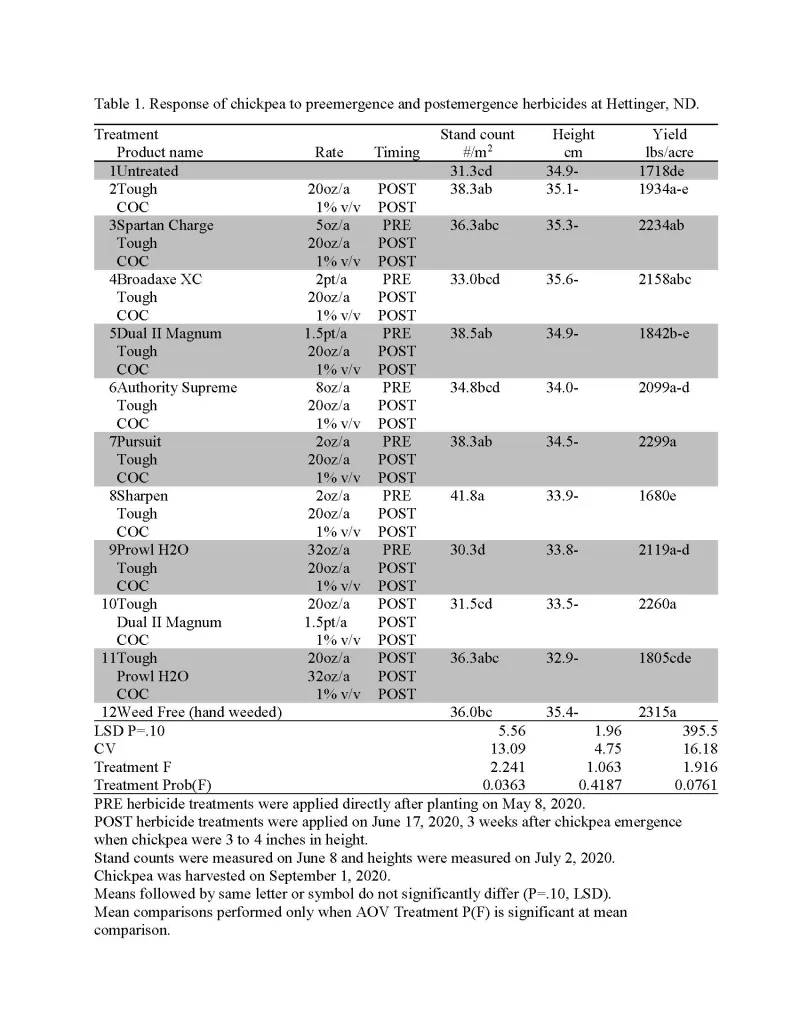Caleb Dalley and Daniel Abe
Hettinger Research Extension Center
Chickpea ‘Frontier’ was planted on May 8, 2020 using a no-till drill at a rate of 40 seeds per square meter (174,000 seeds per acre) with granular chickpea inoculum at 4 lbs per acre. After planting, planned preemergence (PRE) herbicide treatments were applied using a tractor-mounted research plot sprayer using 8002 flat fan nozzles with a spray volume of 15 gallons per acre at a spray pressure of 38 PSI. PRE treatments included sulfentrazone plus carfentrazone (Spartan Charge), sulfentrazone plus metolachlor (BroadAxe XC), metolachlor (Dual II Magnum), sulfentrazone plus pyroxasulfone (Authority Supreme), imazethapyr (Pursuit), and saflufencil (Sharpen). Glyphosate was applied across the entire plot area to control existing weeds. Chickpea emerged on May 27. Postemergence application of pyridate (Tough) herbicide alone and tank-mixed with either pendimethalin (Prowl H2O) or metolachlor (Dual II Magnum) were applied on June 17, 2020 using the same methods described earlier. All treatments were compared with an untreated control (no herbicides other than the glyphosate applied at planting) and a weed free control (which was hand weeded). Stand counts were measured on June 8 using two quadrats (0.5 m2) per plot. Chickpea height (10 random plants per plot) was measured on July 17. Chickpea were harvest on September 1.
Compared with both the untreated and weed free controls, no PRE herbicide treatment resulted in a reduction of chickpea stand which ranged from 30.3 to 41.8 plants per square meter. Plant heights were measure on July 2, two weeks after POST herbicide application. The combination of Tough plus Prowl H2O resulted in injury in the form of abnormal growth (elongated leaves and stems). No other treatment resulted in visual injury (data not shown). Few weeds emerged in this trial due to the dry conditions that occurred following planting and weed control was not evaluated. Yield was greatest in the weed free control, but yield with herbicide treatments was similar to the hand-weeded control with the exception of Dual II Magnum (PRE) followed by Tough (POST), Sharpen (PRE) followed by Tough (POST), and Tough plus Prowl H2O (POST).
The herbicide pyridate (Tough) has now been labelled for use in chickpea in North Dakota. It is a POST herbicide that can be used to control broadleaf weeds. However, applications must be applied when weeds are small 1-2 inches for control. Pyridate is a contact herbicide and as such spray coverage is critical for controlling weeds. Applications should be applied at no less than 15 gallons per acre of spray solution. As pyridate will only control emerged weeds, a PRE herbicide with activity on broadleaf weeds should be applied at planting. However, the results from this trial suggest that combinations of Tough plus Prowl H2O should be avoided due to potential for crop injury.

